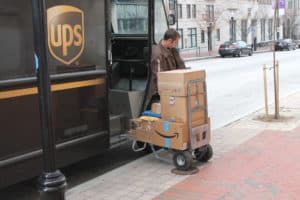Lifting a box here, maneuvering a package there – let’s face it, the life of a UPS package handler isn’t just about sporting those slick brown uniforms. It’s physical, it’s tough, and it’s got you wondering if you’re cut out for the hustle. You’re eyeing that UPS job application but your back twinges just thinking about the weight of the task ahead.
This post is your gym buddy, the spotter to your package-lifting workout, giving you the lowdown on the physical demands of a UPS package handler so you can prep effectively or decide it’s not your jam.
Quick Takeaways:
- Be ready to constantly lift parcels up to 70 pounds, with an average weight of 25 pounds, throughout your shift.
- You’ll need to keep pace with fast-moving conveyor belts, making speed and good decision-making skills critical.
- Stamina, smart lifting practices, and flexible scheduling, especially during peak seasons, are key to handling the demands of the job.
Can You Handle the Weight?
If you’re eyeing a gig as a UPS package handler, let’s talk brass tacks about the weights you’ll be hoisting around. UPS is pretty clear-cut on this: you’ve got to be comfortable lifting packages that weigh up to 70 pounds. Now, while you won’t be doing deadlifts with heavyweights all day long, the average parcel tips the scales at around 25 pounds. That means you’ll need to be in good enough shape to repetitively lift and shift these not-so-light loads throughout your shift.
Remember, it’s not just about being able to lift heavy once; it’s about handling that weight safely and steadily, parcel after parcel. To prepare, you might consider adding some weightlifting into your fitness routine. Train smart, not just hard.
Is Speed Your Ally?
In the hustle and bustle of a UPS sorting facility, time waits for no one—and neither do the conveyor belts. Speed and agility are your best pals in this fast-paced environment. Think of the work like a high-stakes relay race, where keeping the pace means you’re literally moving the wheels of commerce.
Let’s break it down:
– Conveyor belts are relentless. They don’t stop, so your hands and eyes must be in perfect sync to sort and load parcels without missing a beat.
– Sorting demands require swift decision-making. It’s about rapidly determining where a package needs to go next and getting it there, pronto.
– The rhythm of peak periods can make a sprint look like a walk in the park. You’ll need stamina and speed to power through when the parcel floodgates open.
Building your stamina through cardiovascular exercise and interval training can be a real game-changer. Swiftness isn’t just speed—it’s about enduring speed with a clear head.
How Flexible Do You Need to Be?
Flexibility isn’t just for gymnasts or yoga enthusiasts—it’s a necessity for UPS package handlers too. You’ll be bending, stretching, and twisting more than a professional dancer during a marathon performance. Here’s the skinny on the daily physical mash-up:
- Bending and lifting are part of the daily grind, often at awkward angles.
- Twisting and turning to navigate packages from one belt to another is routine.
- Reaching high and stooping low; packages come in all shapes and sizes, and they’re not always within an arm’s reach.
This job asks for a kind of dexterity and flexibility that might take newcomers by surprise. Having a daily stretching routine can work wonders. Also, try incorporating yoga or Pilates into your weekly regimen to keep those muscles limber and ready for action.
But here’s a pro tip that’s often overlooked: invest in a quality pair of work shoes. It’s not just your back that’ll thank you—proper footwear can reduce the strain on your legs and feet when you’re pulling off those package-handler acrobatics day in and day out.
By bolstering strength, agility, and flexibility, you’ll gear up not just to meet the physical demands of a UPS package handler but to outperform them. And that’s not just good for you; it’s good for the flow of packages that keep businesses and consumers smiling. Buckle up, it’s quite the ride.
Do Stamina and Endurance Matter?
Absolutely, when you’re slinging boxes and playing Tetris with parcels in real-time, stamina and endurance aren’t just nice to have; they’re your bread and butter. Working as a UPS package handler isn’t a stroll in the park. It’s a full-on marathon at a sprinter’s pace.
Picture this: You’re hours into your shift, the conveyor belt doesn’t care that you’re tired, and the packages are coming in like waves crashing onto the shore. Good stamina means you can ride those waves without getting wiped out. Endurance is your anchor, keeping you grounded and efficient from the first ding of the clock-in machine to the sweet sound of the clock-out.
Here are a few pointers for staying afloat in this ocean of parcels:
- Pace Yourself: Starting your shift at full throttle might leave you gasping for air halfway through. Learn to maintain a steady, sustainable pace.
- Smart Lifting: Save your back, folks. Using proper lifting techniques is not only safer but less exhausting in the long run.
- Stay Hydrated: Water is your best friend. It keeps those muscles from cramping up and your mind sharp.
- Energy-Boosting Snacks: Keep those nuts or a piece of fruit handy. They’re like quick pit stops for your body’s engine.
Now, we’re not just talking professional advice here. Real-world package handlers often swear by a good pair of shoes. They might not be the first thing you think of for stamina and endurance, but the right support can mean the world after several hours on your feet.
What’s the Deal with Work Schedules?
When considering a role with UPS, keep in mind that the clock doesn’t stop for packages. They’ve got places to be, and you’ve got shifts to work. A package handler’s schedule at UPS is as varied as the parcels that pass through the facility.
Most handlers can expect part-time work, with shifts typically ranging 3 to 4 hours, but here’s the kicker — they’re usually at the crack of dawn or after the sun takes a bow. Why? Because the package world revolves around getting those deliveries out for daytime deliveries and processing returns after everyone else calls it a day.
Now, how do physical requirements change with these quirky hours?
- Early Birds: Morning shifts often handle the overflow from the night before and get goods out for delivery. This means fast-paced sorting and loading under the gun of delivery deadlines.
- Night Owls: Evening shifts deal more with unloading and sorting the day’s returns, as well as prepping for the following day.
During the holiday rush, when online shopping hits levels that would scare a marathon runner, shifts can extend and overnight stints might be added. Picture Black Friday, but it lasts a month, and you’re lifting the deals instead of snagging them.
Here’s a golden nugget of advice: if you’re a newcomer, be ready to flex your schedule. You might find yourself up before the rooster or burning the midnight oil during peak seasons. But, in a unique turn, this can actually play to your advantage. Volunteering for these off-kilter hours can show initiative and, down the line, open doors for more coveted shifts.
Remember, the UPS world is a ticking clock, and every minute counts. Whether you’re handling the first box of the day or the last, your role in the massive machine that is global logistics is pivotal. So, suit up, lace those supportive sneakers, and keep your head in the game. Your endurance and ability to adapt to the UPS schedule isn’t just about personal success – it’s about connecting the world, one package at a time.






![How Long to Wait Before Accepting a Job Offer? [Full Guide] person speaking on smartphone while looking at paper](https://howmonk.com/wp-content/uploads/2022/04/person-speaking-on-smartphone-with-paper-300x200.jpg)


